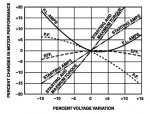robbieb2009
Member
- Location
- West Virginia, United States
Motor: Cemp AB30 | 280 Delta 7.36A / 480 Wye 4.25A | 2.2kW 60Hz.
Measured Incoming Voltages: L-N: 267VAC and L-L: ~467VAC.
Background: Motor was repaired and repair company said they wired the motor up for 480 only internally. They changed it from 6 wires going into the motor internally to only three so no real need for junction box at motor terminals anymore.
Issue: This motor is used for exhaust ventilation on an oven here at the plant to get rid of unwanted VOC's. It is not pulling enough air out. The damper on the intake is set at ~1/4 open right now and its pulling 4A. When the damper is fully opened the current rises to 8-8.5A before it eventually trips the 4A protection circuit.
Question: Is there a way to actually find out what way the repair company wired the motor? If they did wye then I'm assuming I'll need to go to a higher power motor but if they wired it for delta internally by accident I could just switch to a 8A breaker.
What would you guys recommend? I'm a mechanical engineer by nature so I am no where near very knowledgeable on electrical.
Thanks,
Robbie
Measured Incoming Voltages: L-N: 267VAC and L-L: ~467VAC.
Background: Motor was repaired and repair company said they wired the motor up for 480 only internally. They changed it from 6 wires going into the motor internally to only three so no real need for junction box at motor terminals anymore.
Issue: This motor is used for exhaust ventilation on an oven here at the plant to get rid of unwanted VOC's. It is not pulling enough air out. The damper on the intake is set at ~1/4 open right now and its pulling 4A. When the damper is fully opened the current rises to 8-8.5A before it eventually trips the 4A protection circuit.
Question: Is there a way to actually find out what way the repair company wired the motor? If they did wye then I'm assuming I'll need to go to a higher power motor but if they wired it for delta internally by accident I could just switch to a 8A breaker.
What would you guys recommend? I'm a mechanical engineer by nature so I am no where near very knowledgeable on electrical.
Thanks,
Robbie


